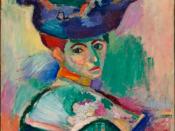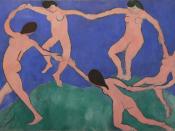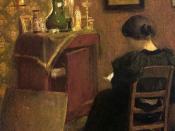Fauvism
For artists, the twentieth century began five years late. Late it might have been, but when it got going, it was decades ahead of it's time. In 1905 nothing was as "modern" as modern art. It was to remain that way throughout the century. There are many people who still fail to understand the art introduced in 1905, over seventy years ago.
That first "modern" art appeared in an exhibition in Paris in 1905. Among the participating artists was one of the century's most famous, Hentri Matisse. Along with Matisse's art were works by Maurice de Vlaminck, Andre Derain, and Georges Rouault. Today the works of these artists hang in museums, but in 1905 they weren't yet famous. To the public they were infamous. Their paintings were so shocking that one newspaper critic called them the work of "Fauves" a French word meaning "wild beasts." The name stuck so that all the artists who exhibited in that 1905 show were ever after called Fauves and their paintings were dubbed Fauve art.
The name "Fauve" was given to the art of Matisse, Vlaminck, and their colleagues, even though they didn't work with a common principle. And, as years passed, their personal art changed. Paintings done by some at the end of their careers little resembled those done at the beginning. Still, the name. "Fauve" continued to be used. These were the pioneering artists of the twentieth century and their art, Fauve painting, was the pioneering movement of our century.
Theory
The fauve artists had no single or unifying principle of art. Perhaps that was necessary for the century's pioneering movement. Their one basic theory was experimentation. That's what shocked the 1905 French Public. Their art was so experimental that it resembled nothing gallery visitors had ever seen before. Fauve art doesn't seem so radical today. That's because their interest in experimentation became the guiding principle of almost all twentieth century art movements. Experimentation in art has meant discovering new types of visual expression. It can be the general theory guiding all the art projects you try in this book. It was originally a fauve principle.
However, if most twentieth-century art movements have been guided by experimentation, those experiments have been controlled by further theories. The leading Fauve theoretician was Henri Matisse. His colleagues followed many of his ideas, and his thoughts about art inspired many twentieth-century art developments. To gain an understanding of Fauve art, you can do no better then examine the art and ideas of Matisse. Nor can you find any better guide for developing your own art. Here is what Matisse once said about his art.
Expression is what I'm seeking most of all ...however, expression doesn't mean the passion which a human face reflects. The total composition of my painting is expressive. My arrangement of figures or objects, the empty spaces surrounding them, their proportions, everything has its roll to play.
Except for Georges Roualt, most Fauve painters followed Matisse and sought expression with the total painting, the total subject. This isn't a simple goal. It's one achieved only after much time and thought. Studying the work of Matisse can help you understand Fauve expression in art.
Matisse expressed himself with line. He did this by simplifying the line in his work. This meant eliminating unnecessary lines and using only the most important. These were, of course, the lines that created the shape of his subjects, not the lines that defined details. He wasn't interested in linear details. In short, he simplified his drawing. But simplified drawing doesn't mean you will automatically produce expressive lines in your art. Simplification can mean producing nothing more than a simple but disjointed sketch. More is required. Matisse and his Fauve friends did it by creating rhythmic lines. His lines swing easily, curve and twist like a melody.
Matisse created such expressive lines in painting like The Dance. The joy of dance requires lines with lovely rhythm. He eliminated details. In the essential lines that remained, he created graceful bends and flowing curves, lines swinging with the delight of dancing.
The Fauves also expressed themselves in color. They understood that color was essential to painting. They didn't feel color should be dominated by subject matter. This means their use of color wasn't dictated by realism. Instead, color could stand on its own. Fauve artists intensified their colors, using bright flesh colors, pinks oranges, and reds for faces. They created shadows of bright colors. In one famous painting, Matisse painted a green stripe down the face of his wife's portrait. He used green because it was the strongest color contrast to the reddish tone of the painting. In such painting, you notice the color before you notice the subject.
Such a bold use of color doesn't mean you can color without thinking. In fact, you must be even more careful with color in such a case. A realistic artist who uses color poorly can claim his inadequate colors only copy the poor coloring of his subject. However, Fauve artists couldn't do this. Their bold coloring was of their own choice so they had to be especially sensitive to the use of color they used in their art. That's why color is such an important ingredient in Fauve art. When you create art in the spirit of Fauve painters, you too will be very conscious of your use of color.
You will also be conscious of your use of line. When thinking like a Fauve artist, you'll experiment. Like Matisse, you'll seek expression in your art in the way you use line and color. You're line will be simplified and your color diverse from realism. Yet your lines will have beauty and expression because you'll give them rhythm and grace. Your colors will be beautiful, because you'll treat them intelligently and with sensitivity. That's how the Fauve artist worked when producing some of the greatest paintings of 20th century art.


